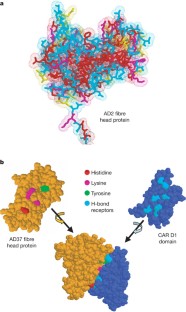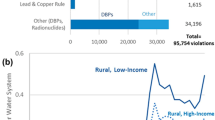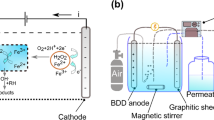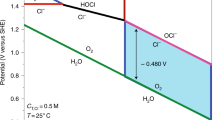Abstract
One of the most pervasive problems afflicting people throughout the world is inadequate access to clean water and sanitation. Problems with water are expected to grow worse in the coming decades, with water scarcity occurring globally, even in regions currently considered water-rich. Addressing these problems calls out for a tremendous amount of research to be conducted to identify robust new methods of purifying water at lower cost and with less energy, while at the same time minimizing the use of chemicals and impact on the environment. Here we highlight some of the science and technology being developed to improve the disinfection and decontamination of water, as well as efforts to increase water supplies through the safe re-use of wastewater and efficient desalination of sea and brackish water.
This is a preview of subscription content, access via your institution
Access options
Subscribe to this journal
Receive 51 print issues and online access
$199.00 per year
only $3.90 per issue
Buy this article
- Purchase on Springer Link
- Instant access to full article PDF
Prices may be subject to local taxes which are calculated during checkout





Similar content being viewed by others
References
Montgomery, M. A. & Elimelech, M. Water and sanitation in developing countries: including health in the equation. Environ. Sci. Technol. 41, 17–24 (2007)
Lima, A. A. M. et al. Persistent diarrhea signals a critical period of increased diarrhea burdens and nutritional shortfalls: a prospective cohort study among children in northeastern brazil. J. Infect. Dis. 181, 1643–1651 (2000)
Behrman, J. R., Alderman, H. & Hoddinott, J. Hunger and malnutrition. in Copenhagen Consensus—Challenges and Opportunities (London, 2004) OCLC 57489365 (London School of Hygiene and Tropical Medicine, 2004); 〈http://www.copenhagenconsensus.com/Files/Filer/CC/Papers/ Hunger%5Fand%5FMalnutrition%5F070504.pdf〉
Singh, P. & Bengtson, L. The impact of warmer climate on melt and evaporation for the rainfed, snowfed and glacierfed basins in the Himalayan region. J. Hydrol. 300, 140–154 (2005)
Shiyin, L., Wenxin, S., Shen, Y. & Li, G. Glacier changes since the Little Ice Age maximum in the western Qilian Shan, northwest China, and consequences of glacier runoff for water supply. J. Glaciol. 49, 117–124 (2003)
Barnett, T. P., Adam, J. C. & Lettenmaier, D. P. Potential impacts of a warming climate on water availability in snow-dominated regions. Nature 438, 303–309 (2005)
Bradley, R. S., Vuille, M., Diaz, H. F. & Vergara, W. Threats to water supplies in the tropical Andes. Science 312, 1755–1756 (2006)
van der Kooij, D. in Heterotrophic Plate Counts and Drinking-water Safety: The Significance of HPCs for Water Quality and Human Health (eds Bartram, J., Cotruvo, J., Exner, M., Fricker, C. & Glasmacher, A.) 199–232 (IWA Publishing, World Health Organization, Geneva, 2003)
Pitman, G. K. Bridging Troubled Waters—Assessing The World Bank Water Resources Strategy (World Bank Publications, Washington DC, 2002)
World Health Organization. Emerging Issues in Water and Infectious Disease 1–22 (World Health Organization, Geneva, 2003)
United States Environmental Protection Agency. 40 CFR parts 9, 141 & 142 National Primary Drinking Water Regulations: Long term 2 enhanced surface water treatment rule; final rule. Federal Register 71, 653–702 (2006)
United States Environmental Protection Agency. 40 CFR parts 9, 141, & 142 National Primary Drinking Water Regulations: Stage 2 disinfectants and disinfection byproducts rule; final rule. Federal Register 71, 388–493 (2006)
Krasner, S. W. et al. Occurrence of a new generation of disinfection byproducts. Environ. Sci. Technol. 40, 7175–7185 (2006)
Muellner, M. G. et al. Haloacetonitriles vs. regulated haloacetic acids: are nitrogen-containing DBPs more toxic? Environ. Sci. Technol. 41, 645–651 (2007)
Centers for Disease Control and Prevention. Safe Water Systems for the Developing World: A Handbook for Implementing Household-Based Water Treatment and Safe Storage Projects (CDC, Atlanta, 2000)
Simonet, J. & Gantzer, C. Inactivation of poliovirus 1 and f-specific RNA phages and degradation of their genomes by UV irradiation at 254 nanometers. Appl. Environ. Microbiol. 72, 7671–7677 (2006)
Nuanualsuwan, S. & Cliver, D. O. Capsid functions of inactivated human picornaviruses and feline calicivirus. Appl. Environ. Microbiol. 69, 350–357 (2003)
Coyne, C. B. & Bergelson, J. M. CAR: A virus receptor within the tight junction. Adv. Drug Deliv. Rev. 57, 869–882 (2005)
Seiradake, E., Lortat-Jacob, H., Billet, O., Kremer, E. J. & Cusack, S. Structural and mutational analysis of human Ad37 and canine adenovirus 2 fiber heads in complex with the D1 domain of coxsackie and adenovirus receptor. J. Biol. Chem. 281, 33704–33716 (2006)
Hawkins, C. L., Pattison, D. I. & Davies, M. J. Hypochlorite-induced oxidation of amino acids, peptides and proteins. Amino Acids 25, 259–274 (2003)
Nightingdale, Z. D. et al. Relative reactivity of lysine and other peptides-bound amino acids to oxidation by hypochlorite. Free Radic. Biol. Med. 29, 425–433 (2000)
Bergt, C., Fu, X., Huq, N. P., Kao, J. & Heinecke, J. W. Lysine residues direct the chlorination of tyrosines in YXXK motifs of apolipoprotein A-I when hypochlorous acid oxidizes high density lipoprotein. J. Biol. Chem. 279, 7856–7866 (2004)
Pattison, D. I. & Davies, M. J. Kinetic analysis of the role of histidine chloramines in hypochlorous acid mediated protein oxidation. Biochemistry 44, 7378–7387 (2005)
Medina-Kauwe, L. K. Endocytosis of adenovirus and adenovirus capsid proteins. Adv. Drug Deliv. Rev. 55, 1485–1496 (2003)
Yates, M. V., Malley, J., Rochelle, P. & Hoffman, R. Effect of adenovirus resistance on UV disinfection requirements: A report on the state of adenovirus science. J. Am. Water Works Assoc. 98, 93–106 (2006)
Li, Q., Liang, W. & Shang, J. K. Enhanced visible-light absorption from PdO nanoparticles in nitrogen-doped titanium oxide thin films. Appl. Phys. Lett. 90, 063109 (2007)
Fu, P., Luan, Y. & Dai, X. Preparation of activated carbon fibers supported TiO2 photocatalyst and evaluation of its photocatalytic reactivity. J. Mol. Catal. Chem. 221, 81–88 (2004)
Medina-Valtierra, J., Garcia-Servin, J., Frausto-Reyes, C. & Calixto, S. The photocatalytic application and regeneration of anatase thin films with embedded commercial TiO2 particles deposited on glass microrods. Appl. Surf. Sci. 252, 3600–3608 (2006)
Changrani, R. G. & Raupp, G. B. Two-dimensional heterogeneous model for a reticulated-foam photocatalytic reactor. Am. Inst. Chem. Eng. J. 46, 829–842 (2000)
Molinari, R., Palmisano, L., Drioli, E. & Schiavello, M. Studies on various reactor configurations for coupling photocatalysis and membrane processes in water purification. J. Membr. Sci. 206, 399–415 (2002)
Lin, H. & Valsaraj, K. T. Development of an optical fiber monolith reactor for photocatalytic wastewater treatment. J. Appl. Electrochem. 35, 699–708 (2005)
Blanco-Galvez, J., Fernandez-Ibanez, P. & Malato-Rodriguez, S. Solar photocatalytic detoxification and disinfection of water: Recent overview. J. Solar Energy Eng. 129, 4–15 (2007)
Gill, L. W. & McLoughlin, O. A. Solar disinfection kinetic design parameters for continuous flow reactors. J. Solar Energy Eng. 129, 111–118 (2007)
Schwarzenbach, R. P. et al. The challenge of micropollutants in aquatic systems. Science 313, 1072–1077 (2006)
Sarkar, S. et al. Well-head arsenic removal units in remote villages of Indian subcontinent: Field results and performance evaluation. Water Res. 39, 2196–2206 (2005)
Khan, A. H. et al. Appraisal of a simple arsenic removal method for groundwater of Bangladesh. J. Environ. Sci. Health Part A 35, 1021–1041 (2000)
Silliman, S. E., Boukari, M., Crane, P., Azonsi, F. & Neal, C. R. Observations on elemental concentrations of groundwater in central Benin. J. Hydrol. 335, 374–388 (2007)
Rasul, S. B. et al. Electrochemical measurement and speciation of inorganic arsenic in groundwater of Bangladesh. Talanta 58, 33–43 (2002)
Chen, Z. L., Akter, K. F., Rahman, M. M. & Naidu, R. Speciation of arsenic by ion chromatography inductively coupled plasma mass spectrometry using ammonium eluents. J. Sep. Sci. 29, 2671–2676 (2006)
Sultan, J. & Gabryelski, W. Structural identification of highly polar nontarget contaminants in drinking water by ESI-FAIMS-Q-TOF-MS. Anal. Chem. 78, 2905–2917 (2006)
Kuo, T.-C. et al. Gateable nanofluidic interconnects for multilayered microfluidic separational systems. Anal. Chem. 75, 1861–1867 (2003)
Liu, J. W. et al. A catalytic beacon sensor for uranium with parts-per-trillion sensitivity and millionfold selectivity. Proc. Natl Acad. Sci. USA 104, 2056–2061 (2007)
Chang, I. H. et al. Miniaturized lead sensor based on lead-specific DNAzyme in a nanocapillary interconnected microfluidic device. Environ. Sci. Technol. 39, 3756–3761 (2005)
Zhu, P. X. et al. Detection of water-borne E. coli O157 using the integrating waveguide biosensor. Biosens. Bioelectron. 21, 678–683 (2005)
Snyder, S. A. et al. Role of membranes and activated carbon in the removal of endocrine disruptors and pharmaceuticals. Desalination 202, 156–181 (2007)
Davis, A. P., Sheppard, D. N. & Smith, B. D. Development of synthetic membrane transporters for anions. Chem. Soc. Rev. 36, 348–357 (2007)
Snyder, S. A., Vanderford, B. J. & Rexing, D. J. Trace analysis of bromate, chlorate, iodate, and perchlorate in natural and bottled waters. Environ. Sci. Technol. 39, 4586–4593 (2005)
Garelick, H., Dybowska, A., Valsami-Jones, E. & Priest, N. D. Remediation technologies for arsenic contaminated drinking waters. J. Soils Sediments 5, 182–190 (2005)
Schideman, L. C., Marinas, B. J., Snoeyink, V. L. & Campos, C. Three-component competitive adsorption model for fixed-bed and moving-bed granular activated carbon adsorbers. Part I. Model development. Environ. Sci. Technol. 40, 6805–6811 (2006)
Magnuson, M. L. & Speth, T. F. Quantitative structure—Property relationships for enhancing predictions of synthetic organic chemical removal from drinking water by granular activated carbon. Environ. Sci. Technol. 39, 7706–7711 (2005)
Yavuz, C. T. et al. Low-field magnetic separation of monodisperse Fe3O4 nanocrystals. Science 314, 964–967 (2006)
Fournier, D., Hawari, J., Streger, S. H., McClay, K. & Hatzinger, P. B. Biotransformation of N-nitrosodimethylamine by Pseudomonas mendocina KR1. Appl. Environ. Microbiol. 72, 6693–6698 (2006)
Kraemer, S. M., Xu, J. D., Raymond, K. N. & Sposito, G. Adsorption of Pb(II) and Eu(III) by oxide minerals in the presence of natural and synthetic hydroxamate siderophores. Environ. Sci. Technol. 36, 1287–1291 (2002)
Chaplin, B. P., Roundy, E., Guy, K. A., Shapley, J. R. & Werth, C. J. Effects of natural water ions and humic acid on catalytic nitrate reduction kinetics using an alumina supported Pd-Cu catalyst. Environ. Sci. Technol. 40, 3075–3081 (2006)
Daiger, G. T., Rittmann, B. E., Adham, S. & Andreottola, G. Are membrane bioreactors ready for widespread application? Environ. Sci. Technol. 39, 399A–406A (2005)
Yang, W. B., Cicek, N. & Ilg, J. State-of-the-art of membrane bioreactors: worldwide research and commercial applications in North America. J. Membr. Sci. 270, 201–211 (2006)
Bixio, D. et al. Wastewater reuse in Europe. Desalination 189, 89–101 (2006)
Kimura, K., Yamato, N., Yamamura, H. & Watanabe, Y. Membrane fouling in pilot-scale membrane bioreactors (MBRs) treating municipal wastewater. Environ. Sci. Technol. 39, 6293–6299 (2005)
Ulbricht, M. & Belfort, G. Surface modification of ultrafiltration membranes by low temperature plasma.2. Graft polymerization onto polyacrylonitrile and polysulfone. J. Membr. Sci. 111, 193–215 (1996)
Carroll, T., Booker, N. A. & Meier-Haack, J. Polyelectrolyte-grafted microfiltration membranes to control fouling by natural organic matter in drinking water. J. Membr. Sci. 203, 3–13 (2002)
Deratani, A., Li, C. L., Wang, D. M. & Lai, J. Y. New trends in the preparation of polymeric membranes for liquid filtration. Ann. Chim.-Sci. Mater. 32, 107–118 (2007)
Hester, J. F., Banerjee, P. & Mayes, A. M. Preparation of protein-resistant surfaces on poly(vinylidene fluoride) membranes via surface segregation. Macromolecules 32, 1643–1650 (1999)
Hester, J. F. & Mayes, A. M. Design and performance of foul-resistant poly(vinylidene fluoride) membranes prepared in a single step by surface segregation. J. Membr. Sci. 202, 119–135 (2002)
Wang, Y. Q. et al. Remarkable reduction of irreversible fouling and improvement of the permeation properties of poly(ether sulfone) ultrafiltration membranes by blending with pluronic F127. Langmuir 21, 11856–11862 (2005)
Asatekin, A., Kang, S., Elimelech, M. & Mayes, A. M. Anti-fouling ultrafiltration membranes containing polyacrylonitrile-graft-poly(ethylene oxide) comb copolymer additives. J. Membr. Sci. 298, 136–146 (2007)
Kang, S., Asatekin, A., Mayes, A. M. & Elimelech, M. Protein antifouling mechanisms of PAN UF membranes incorporating PAN-g-PEO additive. J. Membr. Sci. 298, 42–50 (2007)
Ulbricht, M. Advanced functional polymer membranes. Polymer 47, 2217–2262 (2006)
Akthakul, A., Salinaro, R. F. & Mayes, A. M. Antifouling polymer membranes with sub-nanometer size selectivity. Macromolecules 37, 7663–7668 (2004)
Zhou, M., Kidd, T. J., Noble, R. D. & Gin, D. L. Supported lyotropic liquid crystal polymer membranes: promising materials for molecular-size-selective aqueous nanofiltration. Adv. Mater. 17, 1850–1853 (2005)
Asatekin, A. et al. Antifouling nanofiltration membranes for membrane bioreactors from self-assembling graft copolymers. J. Membr. Sci. 285, 81–89 (2006)
Revanur, R., McCloskey, B., Breitenkamp, K., Freeman, B. D. & Emrick, T. Reactive amphiphilic graft copolymer coatings applied to polyvinylidene fluoride ultrafiltration membranes. Macromolecules 40, 3624–3630 (2007)
Yang, S. Y. et al. Nanoporous membranes with ultrahigh selectivity and flux for the filtration of viruses. Adv. Mater. 18, 709–712 (2006)
Phillip, W. A., Rzayev, J., Hillmyer, M. A. & Cussler, E. L. Gas and water liquid transport through nanoporous block copolymer membranes. J. Membr. Sci. 286, 144–152 (2006)
Nunes, S. P., Sforca, M. L. & Peinemann, K.-V. Dense hydrophilic composite membranes for ultrafiltration. J. Membr. Sci. 106, 49–56 (1995)
Yoon, K. et al. High flux ultrafiltration membranes based on electrospun nanofibrous PAN scaffolds and chitosan coating. Polym. 47, 2434–2441 (2006)
Lu, Y., Suzuki, T. & Zhang, W. Moore, J. S. &Mariñas, B. J. Nanofiltration membranes based on rigid star amphiphiles. Chem. Mater. 19, 3194–3204 (2007)
Zhou, Y. & Tol, R. S. J. Evaluating the costs of desalination and water transport. Wat. Resour. Res. 41, W03003,–1–10 (2005)
Veerapaneni, S., Long, B., Freeman, S. & Bond, R. Reducing energy consumption for seawater desalination. J. Am. Water Works Assoc. 99, 95–106 (2007)
Morgan, L. A. et al. Solar distillation: a promising alternative for water provision with free energy, simple technology and a clean environment. Desalination 116, 45–56 (1998)
Bourounia, K., Chaibib, M. T. & Tadrist, L. Water desalination by humidification and dehumidification of air: state of the art. Desalination 137, 167–176 (2001)
McCutcheon, J. R., McGinnis, R. L. & Elimelech, M. A novel ammonia-carbon dioxide forward (direct) osmosis desalination process. Desalination 174, 1–11 (2005)
Mathioulakis, E., Belessiotis, V. & Delyannis, E. Desalination by using alternative energy: review and state-of-the-art. Desalination 203, 346–365 (2007)
Alonitis, S. A., Kouroumbas, K. & Vlachakis, N. Energy consumption and membrane replacement cost for seawater RO desalination plants. Desalination 157, 151–158 (2003)
Seacord, T. F., Coker, S. D. & MacHarg, J. Affordable desalination collaboration 2005 results. In International Desalination And Water Reuse Quarterly (Green Global Publications, Anaheim, California, 2006)
Spiegler, K. S. & El-Sayed, Y. M. The energetics of desalination processes. Desalination 134, 109–128 (2001)
Hummer, G., Rasaiah, J. C. & Nowotyta, J. P. Water conduction through the hydrophobic channel of a carbon nanotube. Nature 414, 188–190 (2001)
Kalra, A., Garde, S. & Hummer, G. Osmotic water transport through carbon nanotube membranes. Proc. Natl Acad. Sci. USA 100, 10175–10180 (2003)
Hinds, B. J. et al. Aligned multiwalled carbon nanotube membranes. Science 303, 62–65 (2003)
Holt, J. K. et al. Fast mass transport through sub-2-nanometer carbon nanotubes. Science 312, 1034–1037 (2006)
Fornasiero, F. et al. Ion exclusion by sub 2-nm carbon nanotube pores. Proc. Natl. Acad. Sci. USA (in the press)
Walz, T., Smith, B. L., Zeidel, M. L., Engel, A. & Agre, P. Biologically-active 2-dimensional crystals of aquaporin chip. J. Biol. Chem. 269, 1583–1586 (1994)
Qiao, R., Georgiadis, J. G. & Aluru, N. R. Differential ion transport induced electroosmosis and internal recirculation in heterogeneous osmosis membranes. Nano Lett. 6, 995–999 (2006)
Ishida, H., Donowaki, K., Inoue, Y., Qi, Z. & Sokabe, M. Synthesis and ion channel formation of novel cyclic peptides containing a non-natural amino acid. Chem. Lett. Jpn 26, 935–954 (1997)
Davis, A. P., Sheppard, D. N. & Smith, B. D. Development of synthetic membrane transporters for anions. Chem. Soc. Rev. 36, 348–357 (2007)
Nednoor, P., Gavalas, V. G., Chopra, N., Hinds, B. J. & Bachas, L. G. Carbon nanotube based biomimetic membranes: mimicking protein channels regulated by phosphorylation. J. Mater. Chem. 17, 1755–1757 (2007)
Parsegian, A. Energy of an ion crossing a low dielectric membrane: solutions to four relevant electrostatic problems. Nature 221, 844–846 (1969)
Facciotti, M. T., Rouhani-Manshadi, S. & Glaeser, R. M. Energy transduction in transmembrane ion pumps. Trends Biochem. Sci. 29, 445–451 (2004)
Martz, E. Protein explorer: easy yet powerful macromolecular visualization. Trends Biochem. Sci. 27, 107–109 (2002)
van Raaij, M. J., Louis, N., Chroboczek, J. & Cusack, S. Structure of the human adenovirus serotype 2 fiber head domain at 1.5 Å resolution. Virology 262, 333–343 (1999)
Acknowledgements
We acknowledge the US National Science Foundation Science and Technology Center, WaterCAMPWS, Center for Advanced Materials for the Purification of Water with Systems.
Author information
Authors and Affiliations
Corresponding author
Rights and permissions
About this article
Cite this article
Shannon, M., Bohn, P., Elimelech, M. et al. Science and technology for water purification in the coming decades. Nature 452, 301–310 (2008). https://doi.org/10.1038/nature06599
Received:
Accepted:
Issue Date:
DOI: https://doi.org/10.1038/nature06599
This article is cited by
-
Bio-inspired design of next-generation ultrapermeable membrane systems
npj Clean Water (2024)
-
Wood-inspired metamaterial catalyst for robust and high-throughput water purification
Nature Communications (2024)
-
Air-gap-assisted solvothermal process to synthesize unprecedented graphene-like two-dimensional TiO2 nanosheets for Na+ electrosorption/desalination
npj Clean Water (2024)
-
A bio-based nanofibre hydrogel filter for sustainable water purification
Nature Sustainability (2024)
-
Solvent effects in anion recognition
Nature Reviews Chemistry (2024)
Comments
By submitting a comment you agree to abide by our Terms and Community Guidelines. If you find something abusive or that does not comply with our terms or guidelines please flag it as inappropriate.



